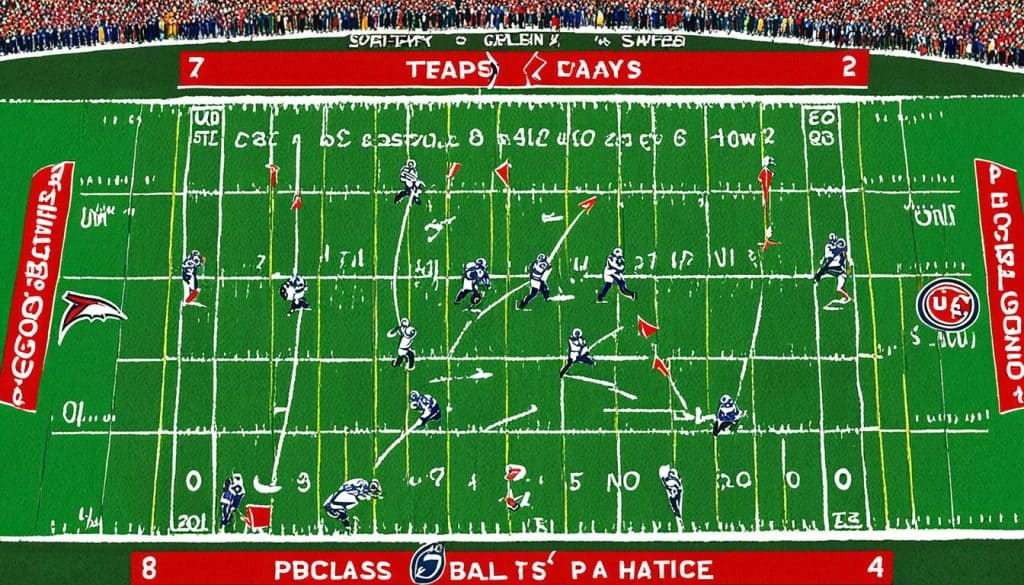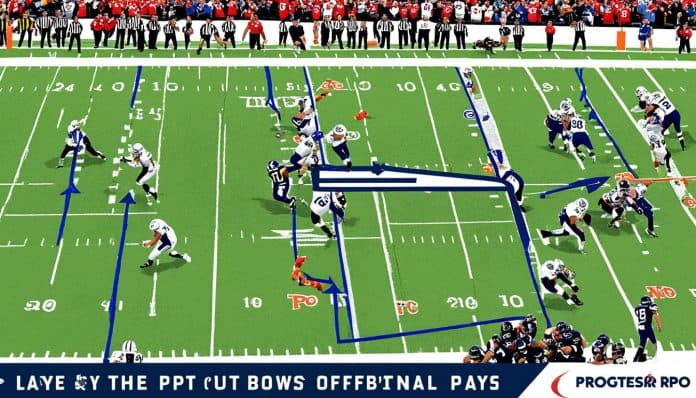The Run-Pass Option (RPO) in football changes how the game is played. It lets the quarterback decide after the play starts. They can choose to hand the ball to a runner or throw a pass. This strategy mixes running and passing into one play. It makes the defense choose quickly how to stop the play, adding lots of pressure.
RPO has become a key part of football, from college to pro leagues. It has changed how teams run their offenses. RPO works well because it catches the defense off guard, leading to big plays. Its growth and use in football show how powerful and game-changing it is.
We’ll look at where RPO came from, how it works, and the rules that help it succeed in football today.
Key Takeaways
- RPO stands for Run-Pass Option and offers dual play possibilities.
- The quarterback’s decision in RPO is based on reading the defensive alignment.
- RPO strategies challenge traditional defensive game-planning.
- Significant rule changes have facilitated the growth of RPO tactics.
- The spread of RPO from college to professional football underscores its effectiveness.
The Evolution of Run-Pass Option in Football
The evolution of RPO has changed football, upgrading tactics in both college and pro levels. This approach, called the Run-Pass Option (RPO), gives teams versatility on offense. Exploring its progress shows how RPO tactics and key rule updates have shifted from colleges to the NFL field.
Origins and Growth of RPO Strategies
In college football, coaches began looking for ways to shake up their offenses. They wanted to make plays harder to predict. RPO, at its core, lets the quarterback choose to pass or run by reading the defense in real time. This flexibility quickly caught on because it’s great for adapting to different defensive looks.
Impact of Rule Changes on RPO Development
Big rule changes in RPO have made it even more popular and effective. An important change lets linemen move up to three yards downfield before a pass. This makes it tough for the defense to know if the play is a run or pass. As a result, RPOs are now much more of a challenge to stop.
The Spread of RPO from College to the NFL
Bringing RPO to the NFL from college was a natural step because it was successful there. More and more NFL teams are using RPOs, and they’re seeing better results on offense. As RPO in the NFL grows, teams are making it a key part of their strategies. They’re tweaking RPO plays to fit their players and the games they play.
| Season | RPO Usage in College Football (%) | RPO Usage in the NFL (%) |
|---|---|---|
| 2015 | 15 | 5 |
| 2018 | 35 | 15 |
| 2021 | 45 | 25 |
What is RPO in Football
The Run-Pass Option (RPO) is a clever mix of run and pass plays. It challenges defenses with a dual threat. To understand RPO, we need to know its basics, like pre-snap and post-snap RPO decisions. We also need to understand the elements that make RPO work well.
Fundamentals of Run-Pass Option
RPO in football gives the quarterback power. They can choose the play based on how the defense lines up. This lets offenses find and use weak spots in the defense. They can change their play on the fly to get the best results.
Distinct Elements of Pre-Snap and Post-Snap RPOs
There are two main parts to an RPO:
- Pre-snap RPO: Before the snap, the quarterback looks at how the defense is set up. They then decide whether to pass or run based on what they see.
- Post-snap RPO: After the snap, the quarterback watches how the defense reacts. Then, they choose whether to pass or run. This makes the play more flexible and responsive.

Every RPO play is good for different situations, depending on how the defense is set up. Coaches and players need to understand and work together on these strategies. This helps their offense be the best it can be.
Executing RPOs: The Quarterback’s Decision-Making Process
For a quarterback, being great at RPOs means understanding the defense and acting fast. They learn to watch the middle defender. This helps choose the best play and avoid mistakes that foul up the game plan.
Understanding Defensive Alignments and Assignments
Quarterbacks must quickly figure out if it’s better to run or pass. They do this by looking at how the defense is lined up. Knowing different defenses and how they react is key to making RPOs work.
How the QB Reads the Conflict Defender
It all comes down to watching the defender who’s likely to tackle. This person tells the quarterback if they should run or throw. It’s about making the defense choose wrong, so the offense wins.
Avoiding Penalties: The Importance of Timing
Getting it done at just the right time stops penalties, like linemen being too far down the field. A quick pass or handoff is essential. By mastering this, quarterbacks make sure their plays are clean and sharp.

Advanced RPO Concepts and Variations
In football, advanced RPO concepts and their variations are key for a team to gain a strategic advantage. These strategies mix up play designs in ways that make it hard for the opposing team to know what’s coming. This can involve giving the quarterback different options to pass to or creating runs that trick the defense. The goal is to find and use the opposition’s weak spots to make big plays or score.
Creating mismatches is crucial in using these advanced RPO ideas effectively. By offering varied ways to move the ball, the team can confuse the defense. This makes the defense spread thin, trying to cover all possibilities. It might cause them to leave open spaces or make other mistakes, which the offense can then use to its advantage.
RPO strategies get teams thinking in creative ways, pushing football forward with new and thrilling plays. For fans and players, this means seeing the sport evolve into something more engaging and unpredictable. To master these advanced tactics, teams need to always be learning and staying up to date with football’s strategy trends. This way, they can keep their plays fresh and challenging, leaving their competitors uncertain and the score in their favor.
























































